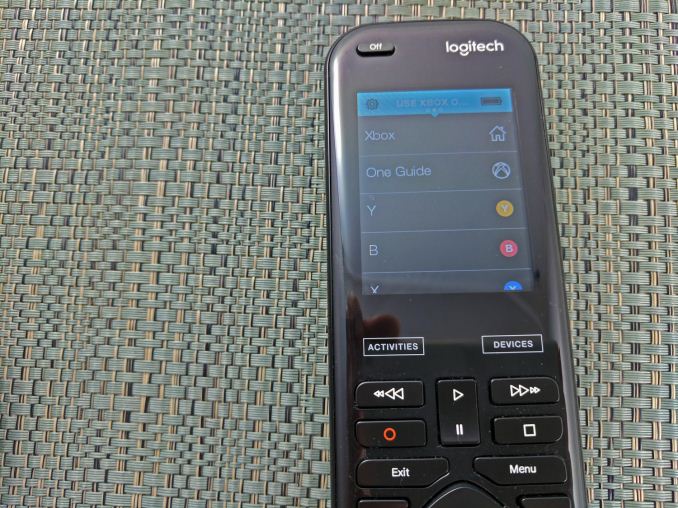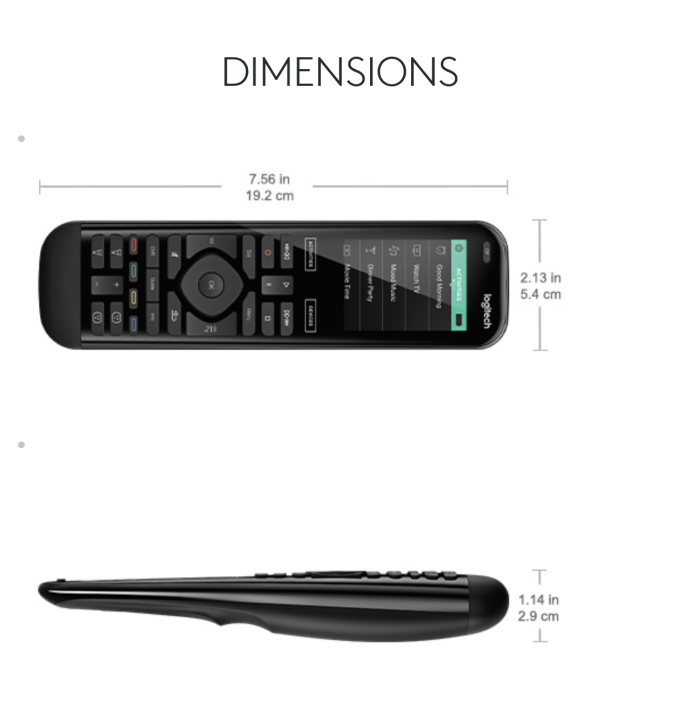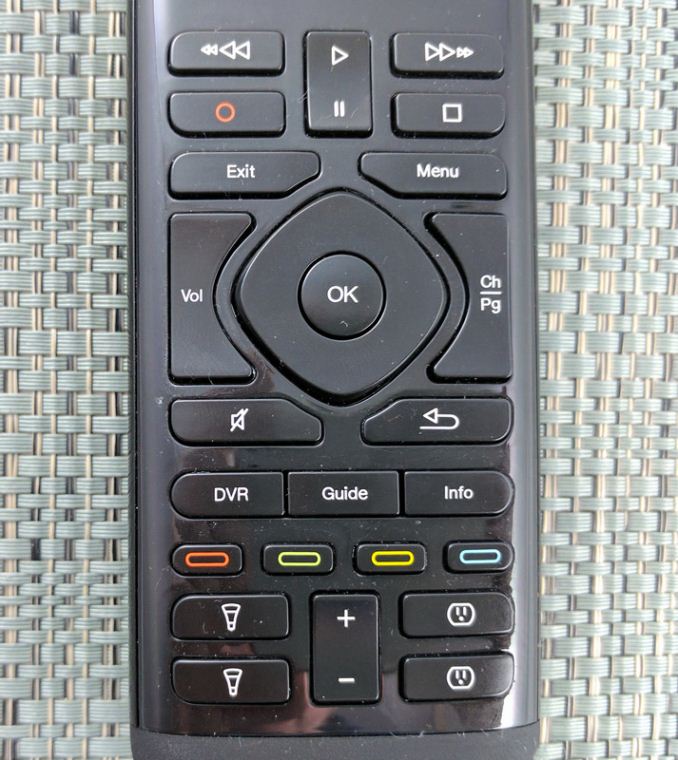The Logitech Harmony Elite Experience: Ultimate Control
by Brett Howse on February 14, 2017 8:00 AM EST- Posted in
- Accessories
- Logitech
- Remote Control
- IoT
- Smart Home
- Harmony
The Logitech Harmony Elite Remote
Before we dig into the software side, let’s first look at the part of the Harmony Elite system you will more than likely use the most, and that is the remote itself. Logitech has meandered over the years in terms of remote design, and they have been putting screens onto remotes for over a decade already, but the Elite is the best design they have ever come up with.
Touchscreens are something we now use every day, but that doesn’t mean they are always the best use case for a given situation. The biggest downside to a touchscreen is that it forces users to interact with it by first looking at it. That might sound obvious, but it’s one of the biggest detractors from a touchscreen as well. Forcing someone to look at a screen can make a simple task into a complex one, at best. At worst, they can be outright dangerous in some scenarios like in a car, where many manufacturers have forgotten that sometimes it’s important to be able to turn on the defrost without going through five menus first. The car scenario is perhaps a stretch when discussing something like a remote control, but the same principles are in effect. Touch requires the user to divert their attention, focus on a screen, ensure the screen is showing the correct options, and then touch it in the right location, where there is little to no feedback that the correct option was touched.
Logitech has made some poor choices over the years with Harmony remotes, to the ultimate (pun intended) mistake of the Harmony Ultimate. This remote featured a touchscreen in the very center of the remote, between the volume and navigation buttons, and the transport buttons. It was an insane decision. Luckily, Logitech has seen the error of their ways, and they’ve now situated the touchscreen at the top of the remote, where it is less likely to be accidentally pressed.
Let’s talk about the screen itself. It’s a 1.5-inch diagonal display with a whopping resolution of 128x128. It can display 65,000 different colors. Considering the use model for the display, it’s adequate, but that is the best thing you can say about it. A sharper screen would go a long way to make the Elite look a bit more premium, especially for the price. The colors are washed out, and the text is pixelated, but at the end of the day, it does function well. For most interactions, the screen is mostly used to choose activities, and to use less-used buttons, so the touchscreen works well in this scenario, since you end up using it less. On a remote control, one of the keys is not needing to look at it, after all. Still, a better display would be one way Logitech could step up their game.
The remote itself is very well designed. The top is a smooth, glossy, black plastic that is pleasing to look at, while the underside is a coarse texture that prevents the remote from slipping out of your hand. It measures 54 mm wide, by 29 mm deep, by 192 mm high (2.13 x 1.14 x 7.56 inches) and unboxing the remote, the short height was one of the first things I noticed. It is significantly shorter than the Harmony One it was replacing. It also weighs 164 grams (5.8 oz) which makes it feel solid, but doesn’t give you any sort of fatigue in use, and most of the weight is near the bottom, meaning it is easier to hold in your hand.
The smaller remote was achieved by removing many of the buttons off the remote, which might sound like a disaster, but in fact, it was very well thought out. The number pad was moved to the touch screen, which is likely the only casualty that will really be noticed, but those were buttons that I never used often so I don’t miss them at all. Other buttons were removed, such as skip, and those could be an issue, except that the Elite allows all buttons to offer two controls. Press is one, and press and hold for a second is another, so skip and fast forward now share the same button (unless you change it of course, since you can). By default, fast forward was press, and skip was press and hold, but in my home that is the opposite of how I would use it, so I swapped them around.
In fact, the removal of buttons has made the remote somewhat easier to use. As an example, delete on my DVR was a button beside the zero on the number pad. With the Elite, it is programmed to be a long press on Stop, which is much easier to access.
Regardless, shrinking the remote has made it more comfortable to use, and much easier to access all the buttons that are there. It really was a smart move. The new buttons are also just the right amount of click, and are an improvement over the Harmony One this model is replacing for me. In over ten years, I’ve never had a Harmony button stop working, and the remotes have been replaced for other reasons, so hopefully that continues to be the case with the Elite.
The remote feels solid, is comfortable to hold, and the layout is much easier to use. After a few generations of Harmony mucking up their remote layout, they seem to have made just the right course corrections with the Elite.














99 Comments
View All Comments
JeffS - Wednesday, February 15, 2017 - link
We have had a Harmony Elite in our home theater for a year now, and it has been a really fantastic product. My wife was basically afraid of using the system until we got this remote, and now she has no problem using it even when I'm not home. The hard buttons are all intuitive, and the touch screen really makes it work. We don't have a particularly complex system and are probably the perfect target customer for the product, but it is complex enough to require multiple remotes if you don't use the Harmony. There's an Epson projector, an Integra AV receiver, a TiVo Mini, a current-gen Apple TV, and a Blu-ray player. The activities on the touch screen are straightforward- "Watch Apple TV," for example, does everything you'd expect. The IR blasters flood the entire room and are so powerful that even reflected IR from the walls controls components. When you're done, the hard "off" button shuts everything down cleanly so that the projector isn't left idling and using up bulb life.We have a lot of tech gadgets in our house. This one is near the top of the list for reliability and ease of use.
fanofanand - Wednesday, February 15, 2017 - link
I'm trying to imagine how ticked off I would be when my kids misplaced a $300 remote.Ratman6161 - Wednesday, February 15, 2017 - link
So, $300 is way more than I'm willing to spend. But I'm intrigued by the hub part which can be purchased separately ($96 on Amazon). Anyone using just the hub and the app without the actual remote?As to the limitations mentioned for the app, I have an older (from 2013) Android phone that doesn't have cell service and continues (at least for now Its android 4.4.4) to run current apps. So if I use this old phone as my remote, or my tablet for that matter, I'm thinking I wouldn't really need the actual remote.
Anyone actually tried this?
rmack350 - Wednesday, February 15, 2017 - link
I also have a Harmony Companion and feel that the Less is More aspect of it works really well. But the specs listed are wrong.The Companion is an RF remote with a coin battery. The coin is supposed to last a year but mine has lasted longer. No recharging required. You can use it anywhere and don't need to be within line of sight, and the remote is simple. The basic learning curve is really short. Honestly, I just use it for TV/STB, TV/Roku. and TV/BlueRay. It has three function buttons for that and you could assign different functions to them for short and long presses but I just skipped the long presses. I bought the thing to simplify the remotes, after all.
The cool thing here is the hub. It's actually the IR emitter and it just flashes the signal at the entire room. It's pretty much always got line of sight this way and it makes the remote more reliable. The problem with a universal remote is that it has to send a set of codes to each device it's controlling. Very often the user would set the remote down out of line of sight before it was finished. Pushing the signalling to the hub gets rid of that fail point. It's very reliable.
There are very few flaws to the Companion remote, except that the buttons are small and unlit. If it weren't for that the companion would make a great gift for elderly people.
CircuitWizardry - Thursday, February 16, 2017 - link
The lack of a hard number pad is a major fail in my opinion. I much prefer to quickly type in the 3 numbers of a channel I want to go to, than use a guide, or a favorite channel list, where I have to look down at a screen on the remote.In my opinion, they had the physical layout correct with the Harmony 900, and it included a blaster. I own three aging 900's, and the IP control would be a nice addition for several devices, but I'll deal with the occasional issue, in exchange for having the numpad.
The real competitor to Harmony is URC, but they won't allow end users access to their programming software... so my money goes elsewhere.
ceomrman - Thursday, February 16, 2017 - link
This whole thing makes me feel old. I used to love this hyper-complicated stuff. I had a Harmony back in the day, but now I use the stock TV remote only, 100% of the time. I have a very good 2.1 system plugged into a mid-range AVR plugged into a smart TV that has Plex and Netflix and Youtube apps. I press "on" and everything fires up. Two presses later and I'm looking at an app menu or watching TV. No need for a hub, since the line of sight to the TV is never a problem. I can adjust my LED lights with their free app. I do sometimes miss the AVR remote for changing the sub level, so I do have to twirl that little knob a couple times a year. Sometimes we put on the radio, but usually for a party or cleaning or something, when using the input knob is no more PITA than using the remote. Sound modes and stuff are gimmicks. I listen to the sound how it was recorded, or admittedly down-mixed if was encoded only in surround. Why would you want to listen to a club mix in Stadium mode? If the movie should have rumbley bass, it'll have it. I've never had any complaint beyond the occasional crappy over-compressed file quality. When we want TV, pressing the "on" button on the remote automatically preempts the radio. I just can't think of what I'd do with a disc player, or what else I'd like a universal remote to do for me. I suppose it'd be nice to control a Roku, but what I'd really like for that (and for the other SnartTV apps, actually) is QWERTY, which Logitech doesn't help with.Kakureru - Friday, February 17, 2017 - link
Ug, still using that garbage "cloud" based software. I need it to 1' work entirly offline without an harmony account, 2, a way to manipulate the codes directly as the software keeps misinterpreting what actually is learned in.Kakureru - Friday, February 17, 2017 - link
Also, I require ACTUAL macros that control my devices AND the remote itself. The "activities" thing does not do what I want.beyondtool - Saturday, February 18, 2017 - link
I cannot fathom why the battery life is still so abysmal. It's definitely the sore point of my Harmony one, over the years there have been many frustrating hours waiting for the damn thing to charge its special battery. It's enough to go back to multiple remotes, rather than pay $300 for this replacement...stangflyer - Saturday, February 18, 2017 - link
I use my Harmony and hub along with an Echo dot to do everything by voice. Now I can pause, forward, reverse anything from my Tivo,UHD player and Roku Ultra. The only thing I have to do is put the disc in the tray as it automatically opens and closes the tray after 10 seconds.